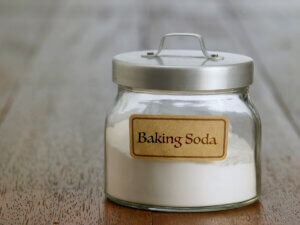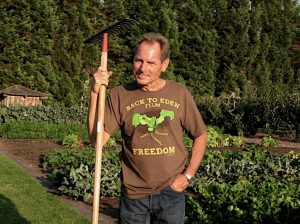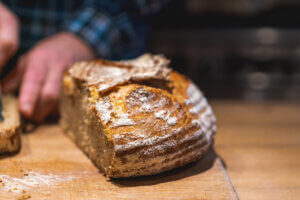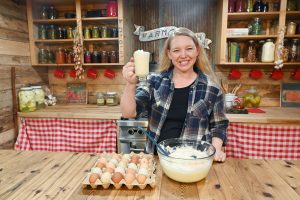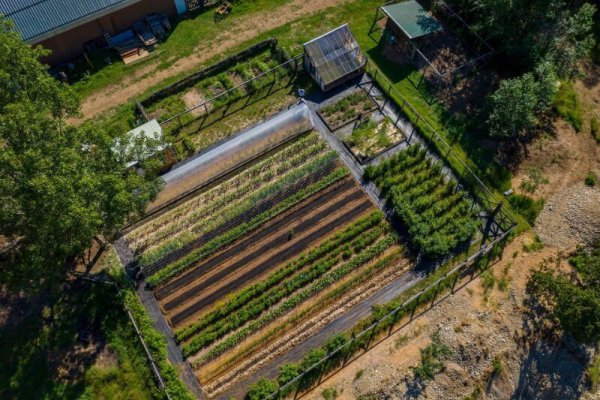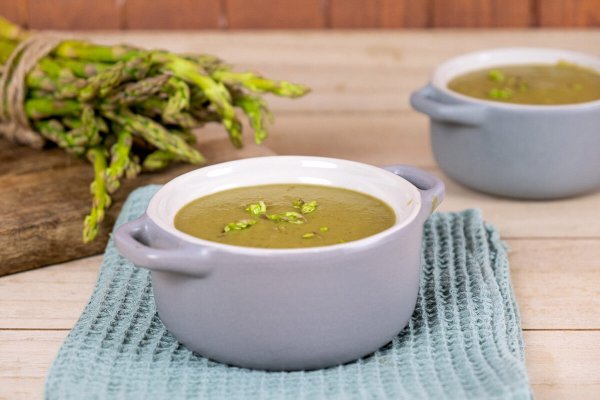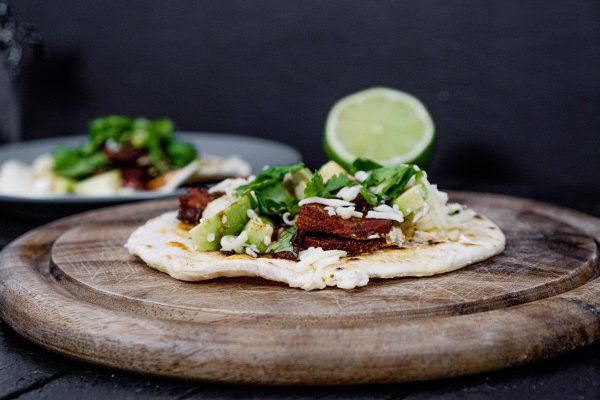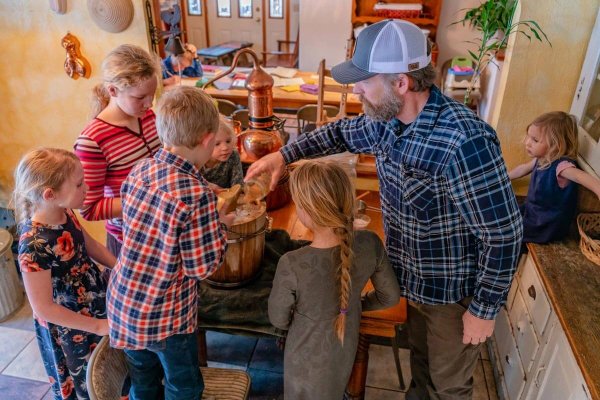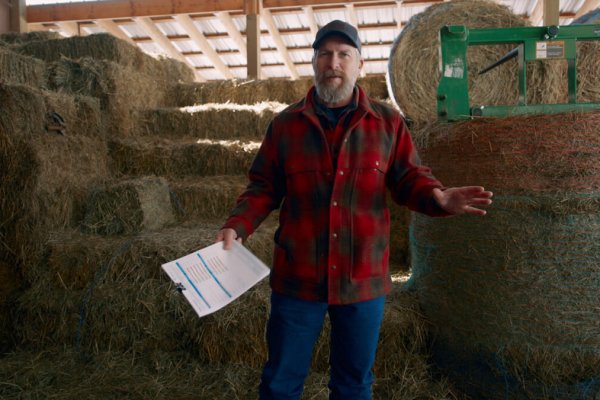
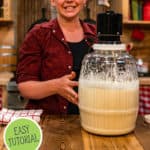

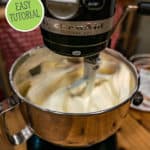
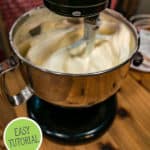
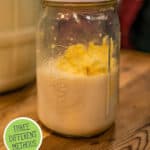
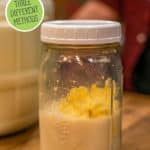
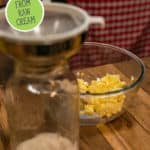

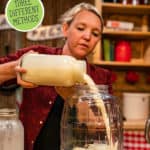
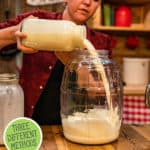

When you have a milk cow, you need to know what to do with all that milk! Learning how to make homemade butter from raw cream or store-bought heavy cream can be simple if you know these tips and tricks. There are subtle nuances you’ll need to know especially when using raw milk or cream. Here are three ways to easily make butter at home.
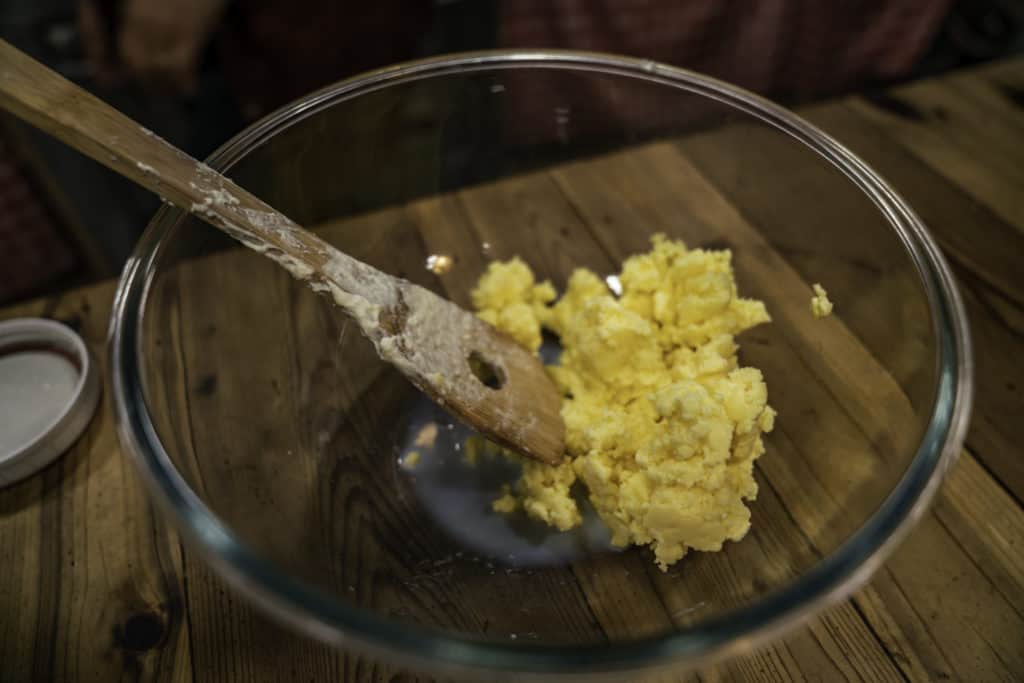
3 Ways to Make Homemade Butter
You can make homemade butter easily many different ways. The three ways we’ll be showing you in this video are:
- In a stand mixer (you could also use a food processor or a blender, though these aren’t my preferred method.)
- A Mason jar
- In an electric butter churn
Each method has slightly different instructions so I’ll clarify them below. But for now, watch this video where I demonstrate each method, plus share tips and tricks for making butter that turns out great each time in the quickest amount of time.
Equipment Needed to Make Butter
All you need is a mason jar with lid, cream, and a hand to shake the jar! It’s literally that simple.
However, there are a few other tools that can help make the process easier and allow you to make larger quantities at a time.
- Mason jar and lid (or stand mixer or electric butter churn)
- Cream
- Large bowl
- Wooden spoon
- Strainer
- Fresh water
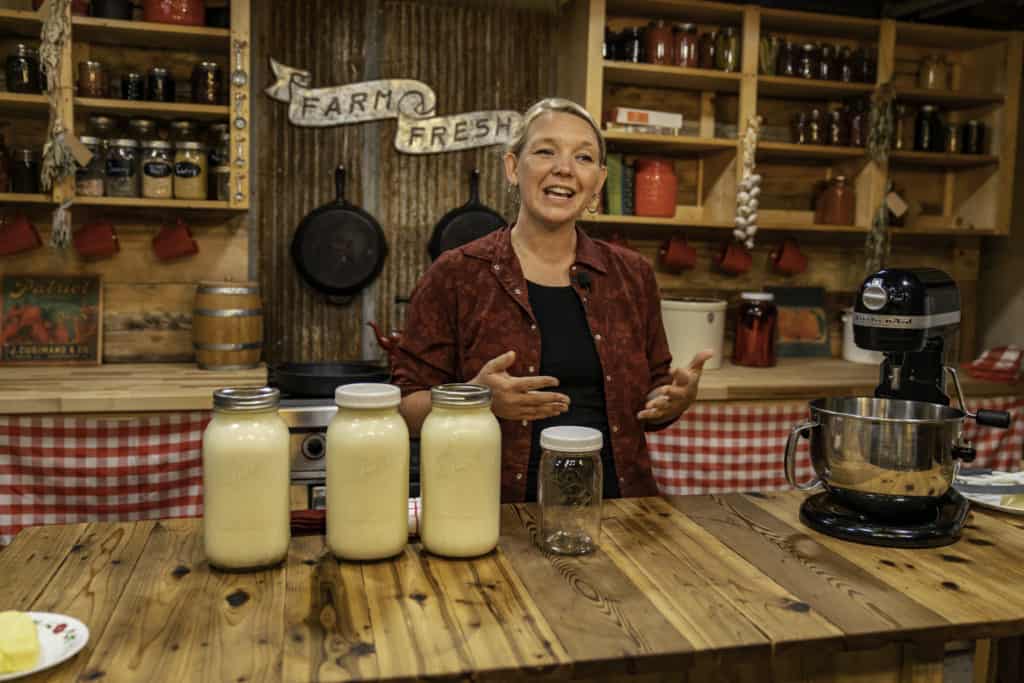
Sweet Cream vs Cultured Butter
You can make two kinds of butter, either sweet cream or cultured butter. What’s the difference between sweet cream and cultured cream for making butter?
Sweet Cream – Making butter from sweet cream is slightly easier than making it from cultured cream because you don’t need to take the step to culture the cream. You’ll end up with a slightly sweeter butter, but it will be lacking in the extra live cultures.
Cultured Cream – Using cultured cream to make butter means you allow your cream to “culture” before churning.
Cultured cream makes healthier butter than sweet cream because the end result is filled with live enzymes, also your finished product will be more consistent.
To culture your cream, leave it out for a day or two at room temperature. This will give you a slightly sour cream which you then churn into butter.
Or, you can culture your cream more quickly by adding about 1 teaspoon of live liquid buttermilk culture (from a previous batch) to 2 cups of fresh raw cream and leave it for about 1-4 hours at room temperature (or place it in the refrigerator overnight).
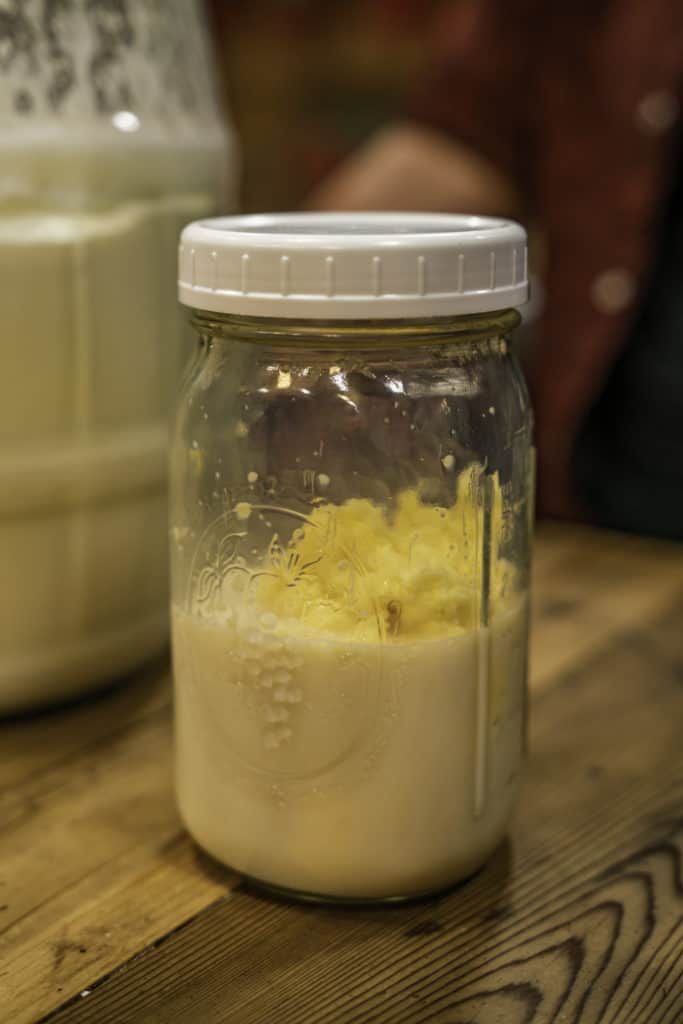
How Much Butter Will My Cream Yield?
The amount varies depending on the cow, the cream, and the time of year (as the cow’s diet/feed changes).
In the summer months, when the cow freshens and is eating more fresh pasture, it’s safe to say that 2 cups of cream (1 pint) will yield approximately 1 cup or 1/2 pound of butter with about 3/4 cup remaining buttermilk. This would be considered high yield.
During the winter months, you may only get about 1/2 cup butter (or 1/4 pound) from 2 cups of cream.
Tips & Tricks
It all comes down to three things: the temperature of the cream, the volume to vessel ratio, and the timing (knowing when to continue or stop churning).
Using Cream that’s the Right Temperature
During the butter-making process, it’s important to be working with the right temperature of cream. The ideal temperature to churn your cream is about 62-63 degrees Fahrenheit.
If your cream is too cold it will take much longer to churn into butter.
If your cream is too warm the butter will have a slimy consistency that’s hard to recover from.
How Much Cream Do I Need?
The amount of cream compared to the size of your vessel is very important. You never want to fill your container over halfway full or you won’t have the room for the butter to expand/slosh.
It’s that sloshing movement that does the actual churning.
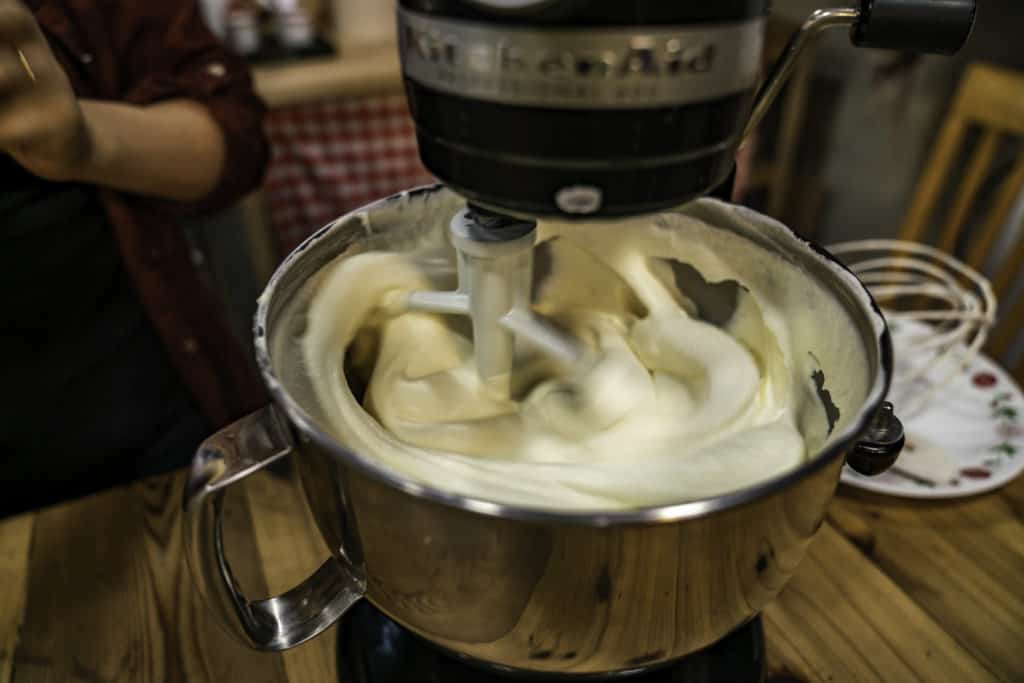
Don’t Undermix and Don’t Overmix!
We like to think about Goldilocks here… you want to continue churning until the butter is “just right”.
It can be tempting to open your jar or stop the mixer to continually check on the consistency of your butter. But just know, when your butter separates from the liquid buttermilk, your jar will get nice and clear, or your bowl will show the separation of butterfat and buttermilk.
In otherwords, it will be obvious! You shouldn’t need to continually check.
If you see little clumps of butter that have separated from the buttermilk, this is great, but you’re not quite done. Keep churning until you have one large chunk of butter (a few small floating pieces is OK).
Once you have a large chunk of butter, stop churning! If you continue to mix you can actually separate your chunks again and ruin your butter.
3 Different Methods For Making Butter
In a Mason Jar
If you watched the video above you’ll see that this can actually be the quickest method for small batches, and it’s so fun to get the whole family involved.
However, if you’re making large quantities of butter at a time, this won’t be your best option, unless you have multiple jars and multiple shakers!
TIP: If you’re using a plastic mason jar lid be sure to put a metal lid on the inside of the plastic lid because they’re not leakproof. Otherwise, a two-part canning lid will work.
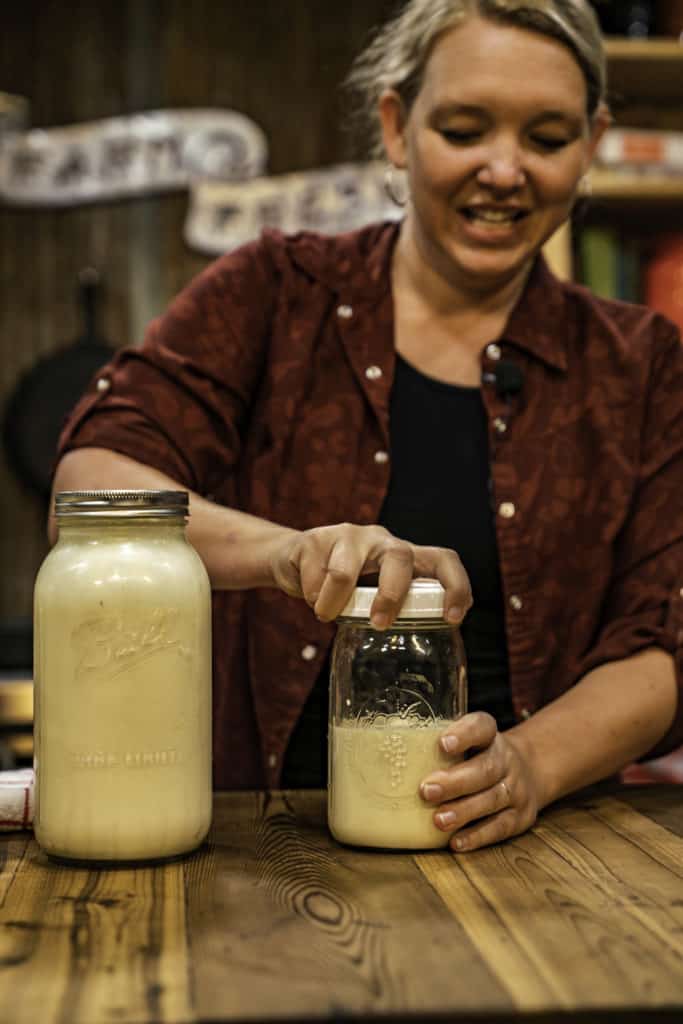
- Fill the mason jar up halfway with cream
- Screw on the lid
- Start shaking away!
- Continue shaking until you have one solid lump of butterfat that has separated out from the buttermilk.
- Once you have a large mass of butter, wash and store your butter (follow the instructions for washing and storing your butter below!)
Get your kids involved in the process and pass the jar to a new person every 30 seconds.
If your cream was at the right temperature when you started, and you cultured it correctly, the cream can turn to butter in as little as five minutes! Once winter comes along and the cow’s feed changes it can, however, take up to 20 minutes (rarely it will take 30 minutes), so get those arms ready!

Using a Kitchenaid, Hand or Stand Mixer
- Starting with the wire whisk attachment, fill your KitchenAid bowl about 1/3 to 1/2 full with cream (to leave room for expansion and sloshing).
- Start mixing on low speed, then turn it up slightly until you reach the light whipped cream stage.
- Once you have a thin whipped cream, switch over to the paddle attachment and continue mixing on medium-high speed.
- After 5-10 minutes you should notice the buttermilk and milkfat separating out.
- Continue churning until you no longer have individual clumps of butter, but one solid lump of butterfat.
- Once you have a large mass of butter, wash and store your butter (follow the instructions for washing and storing your butter below!)
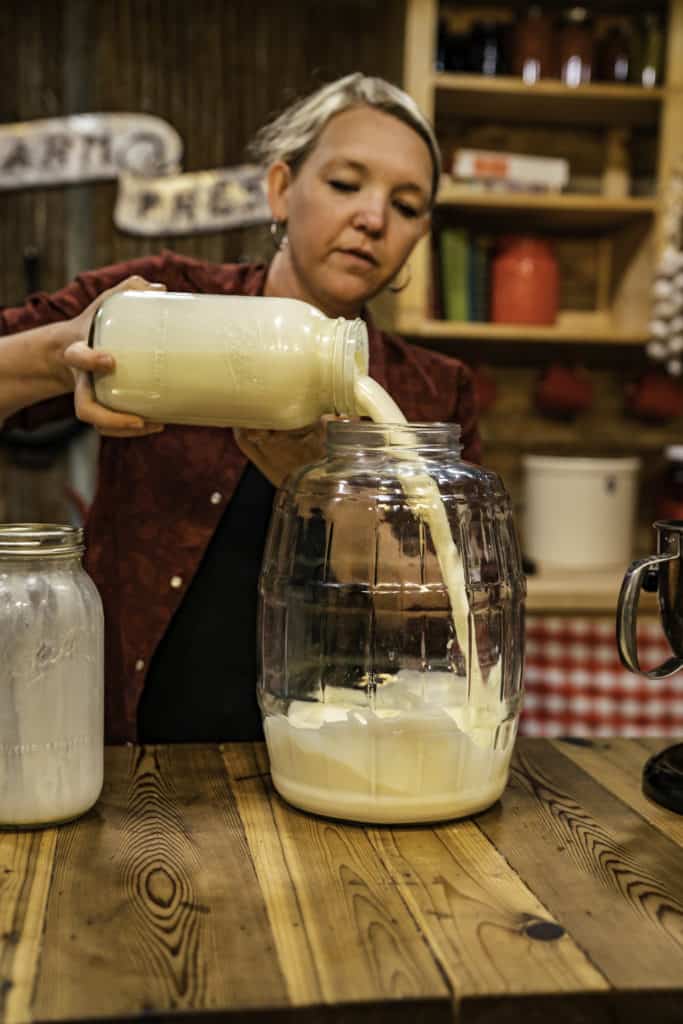
Using an Electric Butter Churn
Using an electric butter churn is handy, but not necessary. We love our 2.5 gallon Buttermeister butter churn from Wisemen Trading because it allows us to make a large quantity of butter at a time (up to a gallon of cream!), which meets our family’s needs because of how much cream we get on a daily/weekly basis.
They do have different sized options, so you won’t have to get one quite as large if that doesn’t suit your needs.
To make butter in the electric churn:
- Fill the butter churn up halfway with cream.
- Place the lid on the butter churn.
- Turn on and let it churn until the buttermilk and butter solids have separated.
- Continue churning until the butter solids begin to clump together.
- Once you have a large mass of butter, wash and store your butter (follow the instructions for washing and storing your butter below!)
No matter which method you’re using, your cream will go from cream to light whipped cream, to heavy whipped cream, to a grainy thick whipped cream (almost like soft ice cream consistency). It will then begin to separate out into butterfat (butter solids) and buttermilk. But don’t stop here! Keep mixing until the butterfat clumps together into a solid mass.

Washing Your Butter
Washing your butter is a very important step. If any of the buttermilk is left in the butter your butter will go rancid very quickly.
Homemade butter doesn’t typically last as long as store-bought butter. This is why we like to freezer our butter and use it up within a week when stored in the refrigerator.
If you’re planning to eat your butter within 24 hours, you don’t need to be as meticulous about getting the buttermilk out.
What Temperature Water To Wash the Butter?
When washing or rinsing the butter be sure you’re using room temperature water. If you use ice-cold water, or even water that’s just too cold from the tap, your butter will get so hard it will be difficult to get all the buttermilk out.
If you use water that’s too warm (or even if the warmth from your hands gets too warm), your butter will begin to melt.
Wash with water that’s in the mid to high 60 degrees and continue to rinse and press your butter until that water runs clear.
TIP: If you find your butter is melting, reduce the temperature in the water. Likewise, if your butter is too firm, increase the water temperature.
Salting Your Butter
Why Salt Butter?
Adding salt is three-fold.
- Salt draws out excess moisture in the butter
- Helps preserve the butter
- Adds flavor to the butter
Even if you don’t care for the flavor of salted butter, it’s important to do so for the preservation of your butter.
How Much Salt?
The amount of salt needed for your butter is determined based on the amount of cream you started with.
- For 1 gallon of cream – use 1 teaspoon of salt
- 1/2 gallon cream – 1/2 teaspoon salt
- 1 quart cream – 1/4 teaspoon salt
- 1 pint cream – 1/8 teaspoon salt
With the butter in a nice clean bowl, add the salt to the butter and continue to knead with your hands.
Try to keep the butter from being mixed back into any liquid that drains out of the butter.
After kneading, thin your butter out on the side angle of your bowl and allow it to sit for about 5 minutes. (See video for demonstration) This allows as much water to drain off as possible.
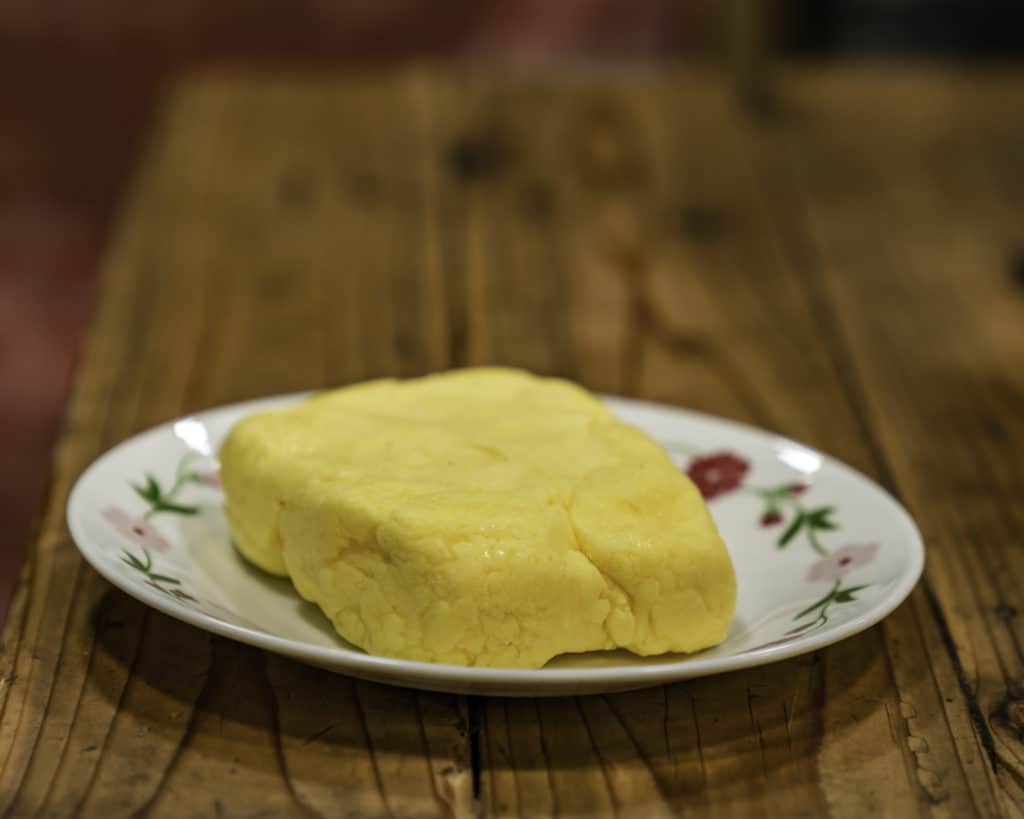
How to Store Homemade Butter
Homemade butter doesn’t store as well as store-bought butter. You can’t stick it in the refrigerator and expect it to stay good for a month or more.
Furthermore, store-bought butter actually has more water content in it to get a lighter, smoother consistency. That’s why your butter is probably harder than you’re used to.
If you’re going to use your butter within a day, (which can be easy to do when you keep 5 minute no-knead bread dough on hand to make fresh homemade bread fast) go ahead and just place it in the refrigerator on a plate. No cover necessary.
If you’re going to use it within 1-2 weeks, you’ll want to wrap your butter so it’s not exposed to the air. Plastic wrap works well here. (We recommend wrapping in a rectangular disc.)
For long-term storage – up to a year, wrap your butter in plastic wrap (1 or even two layers is great) in a flat disc so it defrosts quickly when you’re ready to use it.
Mark the butter well and store in the freezer until you’re ready to use it! Then, follow the storage instructions above.
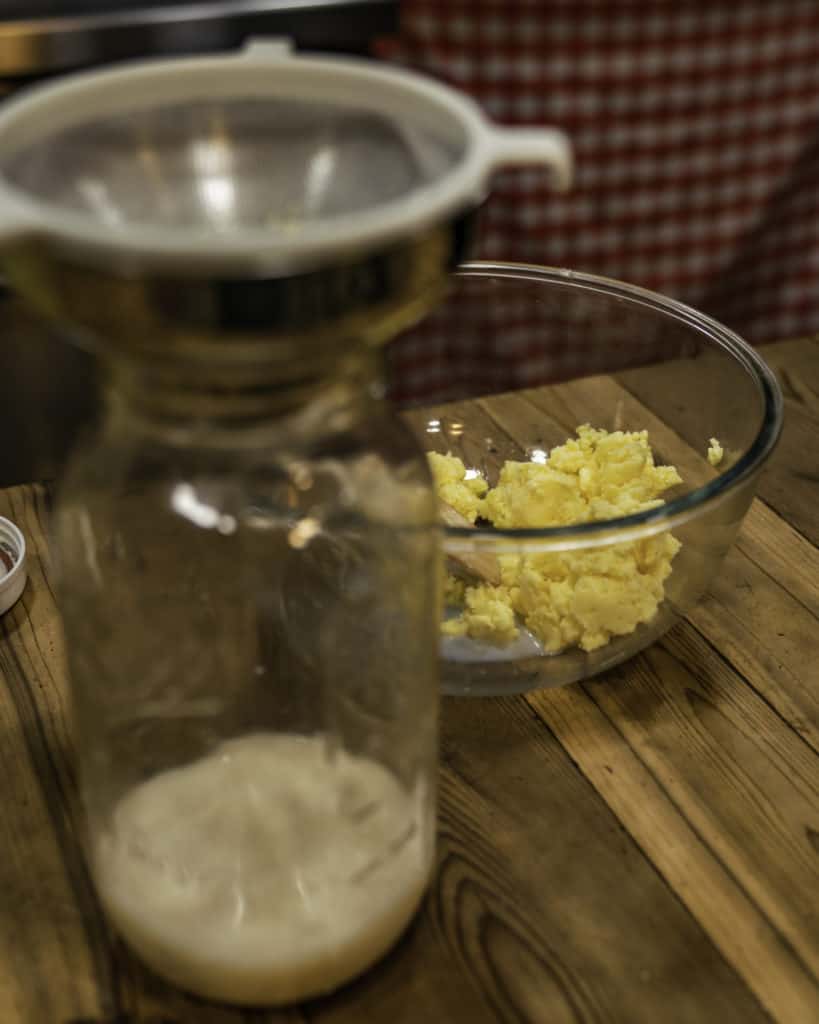
What to do with Buttermilk?
Don’t throw it out! Although this buttermilk is not the same as the buttermilk you’d go buy at the grocery store, it’s still a great product.
Storebought buttermilk is actually made from a whole milk product and is usually cultured.
The buttermilk leftover is great for drinking or baking with. If neither of those options appeals to you, you can always give it to your animals!
Did you make this recipe? If so, please leave a star rating on the recipe card below. Then snap a photo of your homemade butter and tag us on social media @homesteadingfamily telling us which method you used to make it!
Other Posts You May Like
- Clabbered Milk (And the Anatomy of Raw Milk)
- How to Freeze Milk (Or Freeze-Dry Milk)
- Easy Instant Pot Yogurt Recipe (Step-by-Step)
- Homemade Cultured Soft Herbed Cheese
- Can You Make Cheese From Store-Bought Milk?
- Making Homemade Dairy Products Practical
- Raising Goats 101: For Dairy with Anne of All Trades
- Easy Homemade Lacto-Fermented Mayo
- Substitute For Cooking Spray (DIY Non-Stick Cooking Spray)
- Rendering Lard (or Tallow) for Homestead Cooking
- Food Preservation: A Year at a Glance
- Quick & Easy Homemade Mustard
- The Importance of a Healthy Breakfast
- Building Up A Well-Stocked Pantry & Long-Term Food Storage Supply
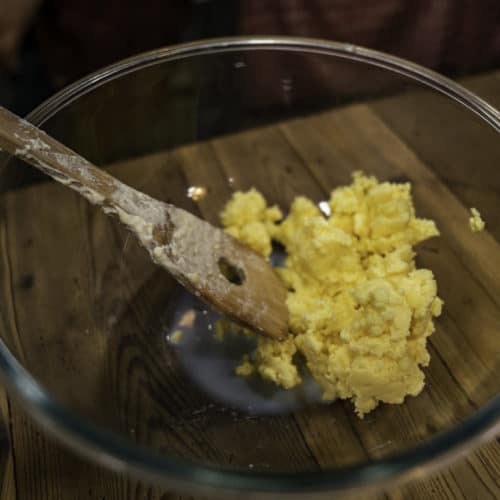
Homemade Butter
Equipment
- Mason Jar with Lid
- Or Kitchen Aid, Hand or Stand Mixer
- Or Electric Butter Churn
Ingredients
- 2 cups cream (more or less depending on vessel size)
- 1/8 tsp salt
Instructions
- Pour cream into mason jar (or other vessel) until it's 1/2 full.
- Screw on the lid (if using a mason jar). Be sure the lid is leakproof.
- Shake the jar until you have one solid lump of butterfat that has separated out from the buttermilk. (If using a stand mixer or electric butter churn, see directions in the post above).
- Once your butter is in one solid lump, strain out the buttermilk and transfer butter to a clean glass bowl.
- Wash your butter by running room temperature water (about 68 degrees) over the butter and mixing with your hands.
- Change out the water 3-4 times until the water runs clear when mixing the butter.
- Salt your butter (1/8 teaspoon for 2 cups cream, or see other ratios above) and mix well, straining out any additional liquid.
- Spread your butter thin onto the side of your bowl and let it rest for 5 minutes to allow any excess water to drain out.
- Wrap your butter in plastic wrap so it's airtight.
- Store the butter in the refrigerator for 1-3 weeks, or freeze for up to a year.
Notes
- Be sure you’re using cream that’s about 62-63 degrees.
- Be sure you’re only filling your vessel 1/2 full to allow room for sloshing and expansion.
- Don’t over or under churn your butter! (See tips in the post above)
- Fresh butter can be stored at room temperature for one day, in the refrigerator (wrapped) for 1-2 weeks and in the freezer (wrapped) for up to a year.


